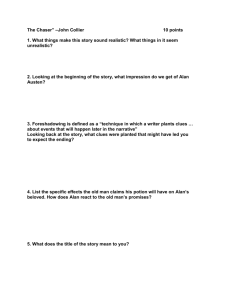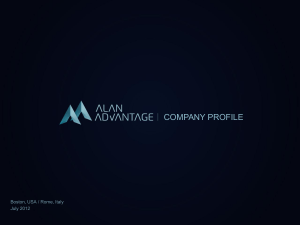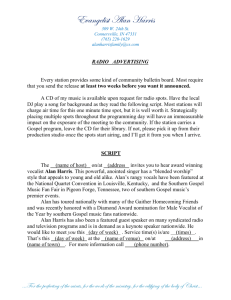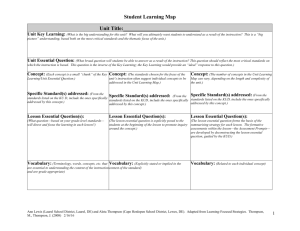Overview of a Business Plan
advertisement
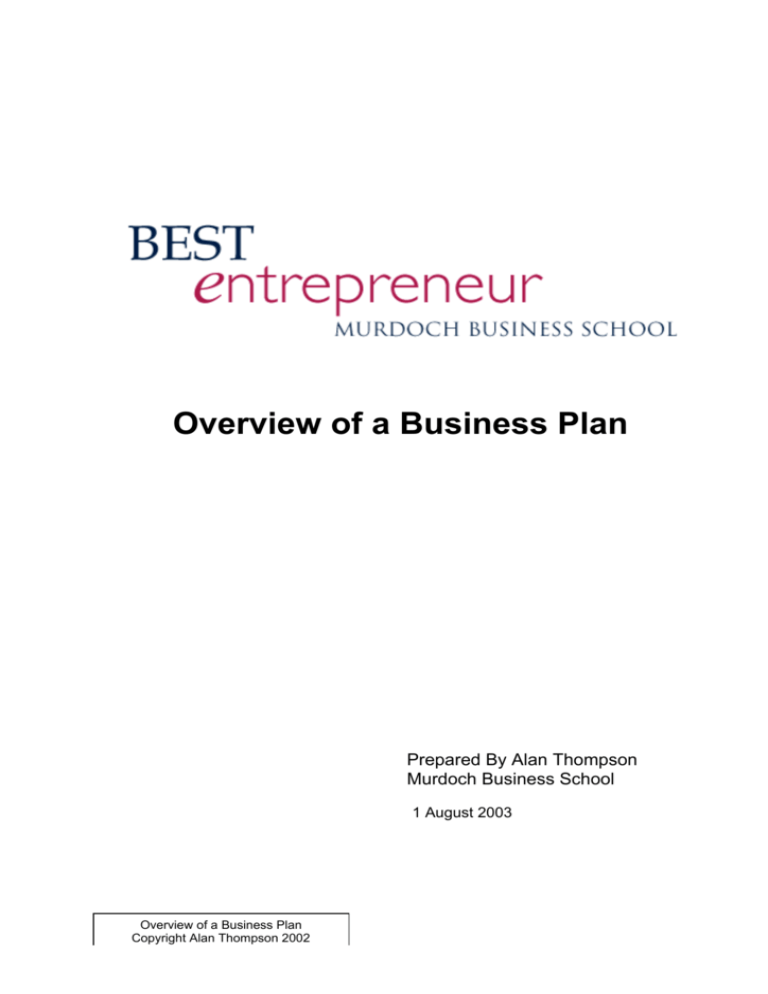
Overview of a Business Plan Prepared By Alan Thompson Murdoch Business School 1 August 2003 Overview of a Business Plan Copyright Alan Thompson 2002 Contents 1.0 Introduction to the Business Plan Concept .....................................................................1 2.0 Function of a Business Plan...........................................................................................1 3.0 The Business Plan Narrative ..........................................................................................2 4.0 Outline of a Business Plan .............................................................................................3 4.1 Executive Summary ...................................................................................................4 4.1.1 Key points to consider for your executive summary:...........................................4 4.2 Table of Contents.......................................................................................................5 4.3 Narrative ....................................................................................................................5 4.3.1 Business Description/Background ......................................................................5 4.3.2 Product/Service..................................................................................................6 4.3.3 Technology ........................................................................................................6 4.3.4 Market Environment ...........................................................................................6 4.3.5 Competition........................................................................................................7 4.3.6 Industry ..............................................................................................................8 4.3.7 Business Model..................................................................................................8 4.3.8 Marketing and Sales Strategy.............................................................................8 4.3.9 Production/Operating Plan..................................................................................9 4.3.10 Management and Personnel.............................................................................10 4.3.11 Governance and Outside Advisors....................................................................10 4.3.12 Intellectual Property..........................................................................................10 4.3.13 Regulations/Environmental Issues ....................................................................11 4.3.14 Financial Summary...........................................................................................11 4.3.15 Critical Risk Factors .........................................................................................11 4.3.16 Milestones........................................................................................................11 4.4 Financial Statements & Narrative .............................................................................12 4.4.1 Financial Narrative ...........................................................................................12 4.4.2 Balance Sheet Projections................................................................................12 4.4.3 Income Statement Projections ..........................................................................12 4.4.4 Cash Flow Projections......................................................................................12 4.4.5 Break-even Analysis.........................................................................................12 4.4.6 Cost Benefit Analysis........................................................................................12 4.5 Appendices..............................................................................................................13 Overview of a Business Plan Copyright Alan Thompson 2002 1.0 Introduction to the Business Plan Concept Before starting a new business or expanding an existing business, you should develop a business plan. The business plan will serve many purposes. First, it will help you define the purpose of your business and organise it. It also helps you determine the business’s growth patterns and any consequent problems before they arise; thus enabling you to more effectively deal with them. The business plan is an agreement on how your management team plans to carry out certain functions to achieve business results and serve as a means of measuring the company’s performance. Lastly, the business plan is a document that will assist when raising capital from banks, private investors, or other sources. The business plan should strongly communicate the business concept, its viability, the business model and the management structure that will be used to reach the business objectives. Here's a road map, or checklist, to guide you in your writing. Although every business plan should reflect the opportunities, concepts and entrepreneurial team that fits a particular business, it is important to consider the full range of issues you and your potential investors are likely to face. A business plan will often build and refine the key concepts developed within the Proof of Business Concept (Feasibility Study) that you conducted to formally justify the business concept prior to committing the resources needed to develop a formal business plan. 2.0 Function of a Business Plan The best business plans are both management guides and selling tools. • Writing a business plan should help you think through most of the issues you will face in starting a business. While you will not prevent all surprises, at least you should be able to plan for the more likely eventualities, freeing yourself to respond creatively to the true surprises. • Communicating a business plan to partners - including investors, major customers or suppliers, and key employees - should generate useful feedback on all aspects of the business. • Finally, the business plan itself should serve as a useful tool - along with personal contact - for convincing such partners to sign on to your vision. Overview of a Business Plan Copyright Alan Thompson 2002 Page 1 3.0 The Business Plan Narrative Strong business plans communicate a compelling story about how a particular business will grow to take advantage of a promising business opportunity. There are four major sections of most plans: • The executive summary - which is written last but presented first opens minds: Here are some very specific bits of information, passion and sophistication that will make you want to read the rest of this plan. • The product-oriented sections educate: Here is my product or service and how it fills a notable need in the marketing place. • The market-oriented sections entice: Look at the fit between the product or service and the niche; look at the shape and size of the market; there should be a great opportunity evident. • The financial and operational sections reassure by anticipating and responding to typical questions: In case you were worried, here is how we will cope with the competition, with industry trends, with regulatory risks, etc. In any case, we have made these very cautious financial assumptions and have a very credible management team capable of responding to almost anything it confronts. There are some things that do not belong in a business plan. For example, while many investors will invest only if they can see an exit strategy and many appreciate an entrepreneur who is sensitive to their need to cash out, few will invest in an entrepreneur who talks about exit strategies unless the exit strategy demonstrates a clear business model for return on investment. Overview of a Business Plan Copyright Alan Thompson 2002 Page 2 4.0 Outline of a Business Plan • Executive Summary • Table of Contents • I. Narrative o Business Description/Background o Product/Service o Technology o Market Environment o Competition o Industry o Business Model o Marketing and Sales Strategy o Production/Operating Plan o Management and Personnel o Governance and Outside Advisors o Intellectual Property o Regulations/Environmental Issues o Financial Highlights o Critical Risk Factors o Milestones • II. Financial Statements & Narrative • III. Appendices Overview of a Business Plan Copyright Alan Thompson 2002 Page 3 4.1 Executive Summary The Executive Summary is a summary of all key sections of the business plan and should work as a separate, standalone document. Investors and lenders read this document first and perhaps glance at the financial section when making a decision. Therefore it is considered the most important component of a business plan. Often investors decide whether to schedule a meeting with the entrepreneur based solely on the Executive Summary. • Write this document after the business plan is completed. • While the ES is written last, it is placed first, either after or before the Table of Contents. • The ES should be no more than one to one and a half pages long. 4.1.1 Key points to consider for your executive summary: • An executive summary should explain why you wrote the report, emphasize your conclusions and recommendation and include only the essential information used to support those conclusions. • Executive summaries are usually organized according to the sequence of information presented in the full report, so follow the order of your report as you discuss the reasons for your conclusions. • Executive summaries are usually proportional in length to the larger work they summarise - typically 5%. Most executive summaries are 1-2 pages maximum. • Write the executive summary after you have completed the report and decided on your recommendations. Look at the first and last sentences of paragraphs to begin to outline your summary. The executive summary should have continuity through the use of key words from within the main report. Make the summary concise, but be sure to show why you've arrived at your conclusions. • You can not introduce any new information that is not in your report. • Executive summaries should communicate independently of the report. That is, tell the whole story in its own right. Ask someone not familiar with the report's examples to read your executive summary to see if it makes sense. Overview of a Business Plan Copyright Alan Thompson 2002 Page 4 • In taking a simplified approach the executive summary should generally consist of three paragraphs, namely: First, communicate the PROBLEM (i.e. introduction, mission, purpose, approach). Second, communicate the SOLUTION (i.e. analysis, facts and recommendations). Third, communicate the SO WHAT (i.e. outcome, success, risk, conclusion). Remember to spell-check and proof read. Don't trust the spellchecker. The executive summary is often the only contact that many people may have with your report/proposal and as these first impressions are significant, get it right first time. A poor executive summary can adversely affect an otherwise great report. 4.2 • 4.3 4.3.1 Table of Contents Include one! Listing sections, appendices, and if necessary, figures, tables, etc. Narrative Business Description/Background Briefly cover the following topics: • When the company was formed, by whom, why the entrepreneurs started the business, and the company's mission. • Which product or products the company will initially focus on. (One to two sentences. Details belong in the product section.) • Initial target market(s). (One sentence.) • Industry. (One sentence.) • Investment profile - who has invested how much when. • Growth, size, and market share objectives, strategy to achieve these, and time frame. • Desired exit strategy (sale of company, IPO, etc.) if any, and time frame. • Milestones achieved to date. For instance: Overview of a Business Plan Copyright Alan Thompson 2002 Page 5 To date, the company has completed a business concept- market feasibility study, has a patent pending in Australia, and is in the process of developing a manufacturing system. It has also raised $25,000 from private investors in a first round of seed financing. 4.3.2 Product/Service • Describe the company's product or service in lay terms. Give a product mix if the company will initially be focusing on more than one product. • Describe how the customer uses the product or service, e.g.., can they use it themselves or would they need to rely on the company in some way. • Describe key components or raw materials that will be used in the product, how the company will source these and how available they are. • State the stage of product design and development. For instance: "The designs and specifications for the first product have been completed, and the prototype will be ready within the next six months." • Describe plans to test the product to ensure it works as planned and is sufficiently durable, rugged, secure, etc. (i.e. consumer product test, beta test with major company, etc.) • Describe plans to upgrade product or expand product line. 4.3.3 Technology • As necessary, provide further technical information about the product or service. • Describe additional or ongoing research and development needs. • Describe the reliability of the technology in terms of prior history, serviceability, upgradeability and marketability. 4.3.4 Market Environment Target Market: • Define and describe the target market(s). Distinguish between end users and customers. • Be clear how end users and customers benefit, and why they would buy the product or service. Overview of a Business Plan Copyright Alan Thompson 2002 Page 6 • What is the unmet need your product(s) or service(s) fulfill so beautifully? How big is the opportunity? For Business-to-Business Markets: • Estimated market size, the industry the target market is in, key players, frequency of product purchases, replacement needs vs. expansion, purchasing process (i.e. solicits bids, uses preferred vendor lists, goes through committee or multilevel approval process, etc.). • Initial targeted geographic area. • Company's targeted market share. • Estimated length of sales cycle. For Business-to-Consumer Markets: • Demographic factors, such as income level, age range, gender, educational level, ethnicity. • Psychographic factors. • Behavioural factors such as frequency of product purchase and shopping behaviour. 4.3.5 Competition • Describe direct and indirect competition (as it pertains to the target markets only). • For key competitors give market share, resources, product and market focus, goals, strategies, strengths and weaknesses. • List all key barriers to entry. • Describe what is unique about the company's product/service compared to the competition. Make sure this is consistent with the unmet need of the target market(s). • State how difficult it will be for competitors to copy the company's product/service. Provide an estimate length of company's lead time (from company's product launch to competitive launch of a copied product). • Describe how competitors will most likely react to the company's product launch and the company's response strategy. Overview of a Business Plan Copyright Alan Thompson 2002 Page 7 4.3.6 Industry • Clearly define and describe the industry in which the company operates. Include the size, growth rate, and outlook. Define key industry segments and state where company fits in. • Describe demand and supply factors and trends. • Describe the larger forces that drive the market - innovation, cultural change, regulation, etc. 4.3.7 Business Model • Describe the company's business model. How will the company generate revenue (i.e. sell the product; charge licensing, subscription or advertising fees; earn commissions from ecommerce; etc.)? Will there be recurring revenue? • If an exit strategy is promoted within the business plan for both you and investors, the business model must be aligned with this and where possible, a business valuation model discussed in order to identify projected return on investment. 4.3.8 Marketing and Sales Strategy • Lay out the marketing and sales strategies. • How have you identified your target market, through existing product alignment, survey methodology or an existing customer base? • Discuss any strategic partnership the company has or is planning to form. Do they provide critical market access or other resources? What are their rights and responsibilities? • Describe the distribution strategy (sell direct to customers through sales force, direct mail, Internet or sell through manufacturers' representatives, wholesalers, distributors or retailers). Provide typical profit margin or markup expectations, commissions, and other expected compensation (co-op advertising, slotting fees, etc.) • Describe the pricing strategy and justification. Include the expected gross profit margins. • Describe typical payment terms for customers. For example; o Customers: 60 days from invoice. o Vendors: 30 days from invoice. • Other issues and their impact (e.g. warranties, liabilities, contracts). • Quantify the marketing budget for at least the first year. Overview of a Business Plan Copyright Alan Thompson 2002 Page 8 4.3.9 • Production/Operating Plan Describe how and where the company will manufacture, source or create and deliver the final product or service. o o o If production and storage will be in-house: Give location, size, age, condition, capacity of planned production and warehouse facilities and number of shifts planned. Will space be owned or leased? Will renovations be required? If so at what cost? How complex is the manufacturing process? Describe equipment needed and costs. If company will outsource production or distribute others' materials: Describe supply sources. Are sources of supply readily available? Give purchase lead times. Outline the relevant contract terms, manufacturer's capacity, minimum order and tooling requirements, reputation, size or financial condition. Describe the company's plan to protect its proprietary processes, trade secrets and quality control. If company is providing a service: How will the service be designed, delivered, monitored and improved? What partners will the company use? What will be the terms of the contract? Are there substitute partners? • Describe the relevant accounting, inventory, management information systems, and operating systems. • Describe relevant risk management strategies for general business risks (e.g. worker's compensation; liability, property, casualty and business interruption insurance; and contingency plans). Overview of a Business Plan Copyright Alan Thompson 2002 Page 9 4.3.10 Management and Personnel • Describe your people philosophy. • List key managers, titles, responsibilities, relevant background, experience, skills. • Briefly describe: o How key decisions will be made. o How management will address management conflicts. • Discuss plans to fill open positions. • Sketch personnel requirements. What people will be needed now, in a year and two years? Include skills and qualifications required. • If the business plan is in support of a new and unproven business, then a detailed profile (resume) of each key manager should be included in appendices. 4.3.11 Governance and Outside Advisors • Describe the ownership structure, including who will be responsible for major decisions about strategy and resource allocation. • Board of Directors or Board of Advisors. If there is or will be one, describe briefly its composition (including internal and external seats), structure, meeting frequency, etc. • A clear (visual) representation of the management and business entity model should be attached as an appendix and referred to when required in the main report. • List professional advisors including roles, experience, qualifications and firms. 4.3.12 Intellectual Property • Briefly describe patents, copyrights, and trademarks obtained and in process. Give all names that are on issued patents. • Summarize results of patent searches. • If company is operating under a licensing agreement or patent assignment, give name of licensor/assignor, describe key terms (i.e. exclusivity, rights, responsibilities) and give termination or renewal date. • If the business concept is a science (research orientated) business, the intellectual property is extremely important. The protocols in managing them, particularly at the initial planning stage are critical. Overview of a Business Plan Copyright Alan Thompson 2002 Page 10 For example, if a researcher has published their research findings in an industry journal or on the internet prior to ensuring intellectual ownership through copyright or patent, then the knowledge is considered in the open domain and therefore can not be considered restricted. What quality control measures have been used to mange the intellectual property process? 4.3.13 Regulations/Environmental Issues • Key government regulations and the company's plans for compliance. • Inspections required, including type and frequency. Outline any environmental problems on property, plans to address the problems and associated costs. • How the company plans to dispose of any waste materials. • Any other regulatory or political issues. 4.3.14 Financial Summary Within the business plan narrative provide a sort of executive summary of the financial section, highlighting key assumptions, significant logic, general projections (e.g. income, expenses, profit all in graph form), break even analysis, funding needs and timing of those needs. Put the details projections, assumptions, etc. - in an appendix. 4.3.15 Critical Risk Factors Describe critical risks faced by the firm (both current or in the future). Examples include internal characteristics, uniqueness, investment, external characteristics, sales growth, product availability, customer availability, technical obsolescence, etc. Be sure to describe how you will mitigate each risk. 4.3.16 Milestones Describe the company's milestones, the major events in life of venture by listing the timetable/deadlines for completion of phases of venture. Be sure to demonstrate the relationship of events and to keep the milestones, financial requirements, personnel requirements, etc. consistent. Overview of a Business Plan Copyright Alan Thompson 2002 Page 11 4.4 4.4.1 Financial Statements & Narrative Financial Narrative • Highlighting key assumptions underlying and logic governing your projections. Include financial history, if any (e.g. equity and debt) and likely financing stages, including information about funding sources and uses. • Provide a page or two of footnotes for each financial spreadsheet attached explaining the assumptions behind each major line item. 4.4.2 Balance Sheet Projections • Three years, if possible. • Highlight inflows of capital. 4.4.3 Income Statement Projections • Year 1: Monthly or quarterly. • Years 2 and 3: Annually 4.4.4 Cash Flow Projections • Year 1: Monthly or quarterly. • Years 2 and 3: Annually 4.4.5 Break-even Analysis • When will the firm begin to turn a profit? • When will investors begin to see a return? III (linkage to any exit strategy is important). 4.4.6 Cost Benefit Analysis • The cost benefit analysis should have already been conducted within the feasibility study as to the overall viability of the business concept and model. • The cost benefit analysis is traditionally attached as an appendix either as part of the feasibility study or as a separate business plan appendix. • The cost benefit analysis will often be referred to in the business concept introduction component of the business plan and again in the conclusion if a conclusion is warranted. Overview of a Business Plan Copyright Alan Thompson 2002 Page 12 4.5 Appendices • Management resumes/bios. • Copies of patents. • Promotional materials. • Visualization of product or service. • Management Milestones – table format. • Business Concept Study or components there of. • Supporting analysis and / or research • References and other documentation • Accountants Financial Certification End of Document Special Note: Proof of Business Concept (Feasibility Study) vs Business Plan Traditionally a proof of business concept (feasibility study) is conducted prior to the business plan being completed. A proof of business concept proves the fiscal and business viability of the proposed business. However it is often the case that no feasibility study is conducted, and the business manager, owner, or entrepreneur will go directly to the business plan preparation. It is import ant in such cases the business plan also contain key components of the proof of business concept so that the business plan not only communicates the management model but also provided evidence of the justification (validation) of the business itself. Overview of a Business Plan Copyright Alan Thompson 2002 Page 13
